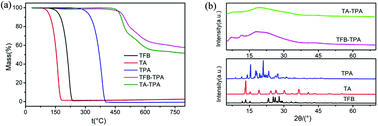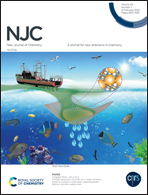Facile fabrication of triphenylamine-based conjugated porous polymers and their application in organic degradation under visible light†
Abstract
A facile fabrication method was developed for the one-pot synthesis of triphenylamine-based conjugated porous polymers (TFB-TPA, TA-TPA) under ambient conditions using the combination of 1,3,5-triformylbenzene (TFB), 4,4′4′′-triaminotriphenylamine (TPA), and terephthalaldehyde (TA) as building blocks via a Schiff-base reaction. The obtained polymers were well characterized and the results demonstrated that both TFB-TPA and TA-TPA possess the advantages of excellent thermal stability and large specific surface area. The photoelectrical properties of TFB-TPA and TA-TPA were investigated by UV-Vis diffused reflection spectroscopy (DRS) and electrochemical analysis techniques. Tobramycin, methyl orange, and hydroquinone were chosen as model pollutants to further explore the potential of the obtained triphenylamine-based polymers as visible-light-driven photocatalysts for organic degradation. Experiment results suggested that the as-prepared TFB-TPA exhibits acceptable catalytic performance for the degradation of organic contaminants under visible light irradiation. This study may not only open feasible paths to the large-scale synthesis of triphenylamine-based conjugated porous polymers, but also provide a strategy to design and fabricate metal-free polymeric photocatalyst with tunable photoelectrical properties.



 Please wait while we load your content...
Please wait while we load your content...